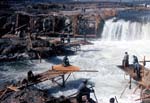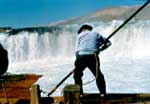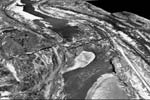| Since time immemorial, the fish runs located around Celilo Falls and The Dalles have brought hundreds of Indian fishermen and traders from throughout the Pacific Northwest and farther during the spring and fall salmon runs on the Columbia River. They came with their families to trade, to socialize, to play, and to fish with their relatives and friends. It was an area central to the heartbeat of our people.
|
|
Brenda Scott, of Wasco and Paiute heritage, tells how the Celilo area was a central trading center, with tribes coming as far away as the central Plains to trade buffalo robes. (Interviewed by Brigette Whipple and F. Duran Bobb, October 18, 2002) |
 | | Boy with his Eels, ca. 1950s. |
They celebrated the arrival of the salmon with a special ceremony in appreciation of a food source so vital to them at that time as it is today. Salmon is the first in a chain of seasonal foods blessed upon the people by the Creator. Our ancestors handed down stories about thousands upon thousands of salmon that can be seen as they jumped the falls in their journey up the river. It was known for the fisherman to spear fish from the banks of the river. The salmon that arrived in mid-April were particularly desirable because of their high fat content and wonderful taste. It is one reason why our salmon was the most prized of all the Columbia River salmon.
|
| View of the Celilo Falls area in 1922, before The Dalles Dam was built and flooded the falls, as a fly-over, three-dimensional image. Also view the falls at a 512k speed. (3-D "fly-over" simulation taken from 1922 aerial photographs and created by Jim Crocker of the Confederated Tribes of Warm Springs GIS Program, 2002) |
The women prepared the salmon. Throughout the village there where rows and rows of salmon lined up, hanging from make-shift poles to wind dry. Large quantities of dried salmon were made in this way. Some of the dried salmon were pounded and mixed with other ingredients. They were then stored in special bags made especially for this. The spring season was also harvest time for the various roots that grew generally along the river and outside the area. While some women prepared salmon, others gathered roots and prepared them for drying and storing.
|
|
Harrison Davis Sr. discusses camping at Celilo Falls. (Interviewed by Brigette Whipple and F. Duran Bobb, January 16, 2003) |
In addition to the hard work there was some play at the Celilo Village with its many visitors. In the evening, men and women dancers put on their best beadwork and feathers to social dance to the special songs sung by the drummers. Others gathered and formed teams to play competitive bone games, making wagers of wampum, beads or dentilium at games that can last long into the night. Yet others brought their prized horses in hopes of finding a steed worthy of racing.
|
|
Brenda Scott talks about the continued use of the Celilo area, for getting a winter supply of fish for the family and camping year-round at the former falls. (Interviewed by Brigette Whipple and F. Duran Bobb, October 18, 2002) |
Celilo Falls and its surrounding area were the most important trade and communication centers on the entire Columbia River Plateau. Tribal members from as far away as Montana to the east, British Columbia to the north, the Pacific Coast to the west, and California to the south regularly traveled to this vital commerce location to trade with the local tribes. Among the important trade goods brought to Celilo Falls from the tribes to the east were obsidian stones, beargrass, basketry, dried deer meat, buffalo hides, and catlinite stone pipes. Obsidian was also came from the south, near Newberry and Glass Butte. Indian groups from the west brought such trade items as dugout canoes, cedar paddles, wappato roots, smoked sturgeon, and dentalium shells to decorate clothing. And for these items, the Wasco and Warm Springs peoples traded their highly soughtafter salmon they had caught from the Big River.
|
|
Harrison Davis Sr. tells of the 80 pound salmon that were once caught on the river. (Interviewed by Brigette Whipple, January 2003) |
As the salmon run slowed, the villages created storage holding bins that were filled with dried salmon for later use. Many visiting families broke camp for a return to their own homes. They assembled travois and loaded them with their own winter bundles of dried salmon and roots to make the treks home. And thus another season at the Celilo village had ended, having taken place two hundred years ago or a thousand years ago.
|
|
Harrison Davis Sr. talks about "fish roping" as another technique of salmon fishing. (Interviewed by Brigette Whipple, January 2003) |
For centuries the Celilo Village has undergone tremendous changes. Archeological digs prior to the completion of The Dalles Dam confirmed that Indian people had continuously occupied the village site for at least 11,000 years.
|
|
Harrison Davis Sr. talks about the use of stationary nets for salmon fishing. (Interviewed by Brigette Whipple, January 2003) |
In October of 1805, Lewis and Clark called this place the Great Falls, the first falls of the Columbia River. In the journals of Lewis and Clark this is what they said of the Celilo area. “We found a great number of fishing camps and halted for a short time a small distance above the falls around noon time. We found the natives to be very numerous and came to us, where we purchased some pounded salmon and root bread. They had a number of lodges made out of Flags and cedar bark and cabins built out of same kind of cedar work and covered with bark. We saw a number of canoes lying along the shores of the river. We saw a number of handsome horses feeding in the plains which belonged to the natives. These falls were perpendicular and we found them by measurement to be about 37 feet 8 inches feet high and full of solid rocks which by the force of the rapidity of the waters running, are cut into many channels. And a constant mist rises at this place occasioned by the great fall of water.”
While Celilo Falls was dynamited and destroyed as part of the creation of the The Dalles Dam, and then inundated by the flood waters from the dam on the 10th of March 1957, the salmon continues to be a vital food source as well as spiritually meaningful to all tribes along the Columbia River.
© Confederated Tribes of Warm Springs 2003
| next >
|


















